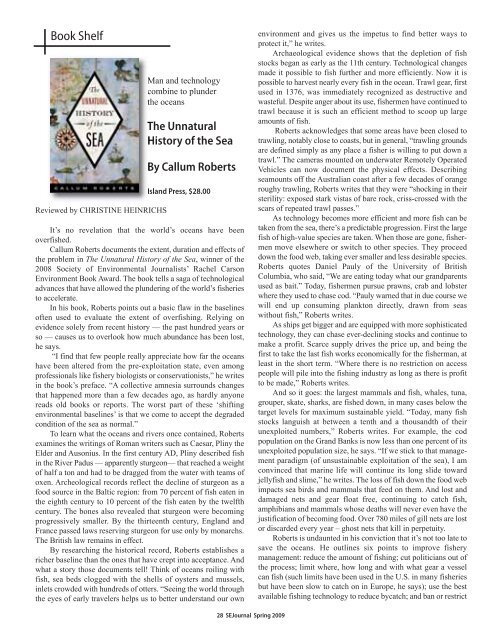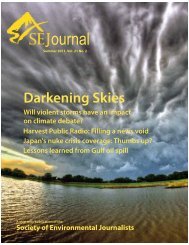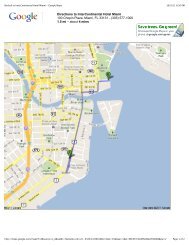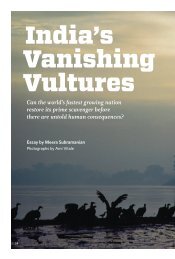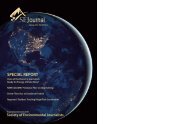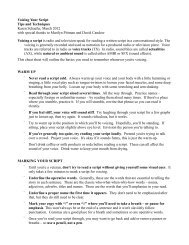PDF Download - Society of Environmental Journalists
PDF Download - Society of Environmental Journalists
PDF Download - Society of Environmental Journalists
Create successful ePaper yourself
Turn your PDF publications into a flip-book with our unique Google optimized e-Paper software.
Book ShelfReviewed by CHRISTINE HEINRICHSMan and technologycombine to plunderthe oceansThe UnnaturalHistory <strong>of</strong> the SeaBy Callum RobertsIsland Press, $28.00It’s no revelation that the world’s oceans have beenoverfished.Callum Roberts documents the extent, duration and effects <strong>of</strong>the problem in The Unnatural History <strong>of</strong> the Sea, winner <strong>of</strong> the2008 <strong>Society</strong> <strong>of</strong> <strong>Environmental</strong> <strong>Journalists</strong>’ Rachel CarsonEnvironment Book Award. The book tells a saga <strong>of</strong> technologicaladvances that have allowed the plundering <strong>of</strong> the world’s fisheriesto accelerate.In his book, Roberts points out a basic flaw in the baselines<strong>of</strong>ten used to evaluate the extent <strong>of</strong> overfishing. Relying onevidence solely from recent history — the past hundred years orso — causes us to overlook how much abundance has been lost,he says.“I find that few people really appreciate how far the oceanshave been altered from the pre-exploitation state, even amongpr<strong>of</strong>essionals like fishery biologists or conservationists,” he writesin the book’s preface. “A collective amnesia surrounds changesthat happened more than a few decades ago, as hardly anyonereads old books or reports. The worst part <strong>of</strong> these ‘shiftingenvironmental baselines’ is that we come to accept the degradedcondition <strong>of</strong> the sea as normal.”To learn what the oceans and rivers once contained, Robertsexamines the writings <strong>of</strong> Roman writers such as Caesar, Pliny theElder and Ausonius. In the first century AD, Pliny described fishin the River Padus — apparently sturgeon— that reached a weight<strong>of</strong> half a ton and had to be dragged from the water with teams <strong>of</strong>oxen. Archeological records reflect the decline <strong>of</strong> sturgeon as afood source in the Baltic region: from 70 percent <strong>of</strong> fish eaten inthe eighth century to 10 percent <strong>of</strong> the fish eaten by the twelfthcentury. The bones also revealed that sturgeon were becomingprogressively smaller. By the thirteenth century, England andFrance passed laws reserving sturgeon for use only by monarchs.The British law remains in effect.By researching the historical record, Roberts establishes aricher baseline than the ones that have crept into acceptance. Andwhat a story those documents tell! Think <strong>of</strong> oceans roiling withfish, sea beds clogged with the shells <strong>of</strong> oysters and mussels,inlets crowded with hundreds <strong>of</strong> otters. “Seeing the world throughthe eyes <strong>of</strong> early travelers helps us to better understand our ownenvironment and gives us the impetus to find better ways toprotect it,” he writes.Archaeological evidence shows that the depletion <strong>of</strong> fishstocks began as early as the 11th century. Technological changesmade it possible to fish further and more efficiently. Now it ispossible to harvest nearly every fish in the ocean. Trawl gear, firstused in 1376, was immediately recognized as destructive andwasteful. Despite anger about its use, fishermen have continued totrawl because it is such an efficient method to scoop up largeamounts <strong>of</strong> fish.Roberts acknowledges that some areas have been closed totrawling, notably close to coasts, but in general, “trawling groundsare defined simply as any place a fisher is willing to put down atrawl.” The cameras mounted on underwater Remotely OperatedVehicles can now document the physical effects. Describingseamounts <strong>of</strong>f the Australian coast after a few decades <strong>of</strong> orangeroughy trawling, Roberts writes that they were “shocking in theirsterility: exposed stark vistas <strong>of</strong> bare rock, criss-crossed with thescars <strong>of</strong> repeated trawl passes.”As technology becomes more efficient and more fish can betaken from the sea, there’s a predictable progression. First the largefish <strong>of</strong> high-value species are taken. When those are gone, fishermenmove elsewhere or switch to other species. They proceeddown the food web, taking ever smaller and less desirable species.Roberts quotes Daniel Pauly <strong>of</strong> the University <strong>of</strong> BritishColumbia, who said, “We are eating today what our grandparentsused as bait.” Today, fishermen pursue prawns, crab and lobsterwhere they used to chase cod. “Pauly warned that in due course wewill end up consuming plankton directly, drawn from seaswithout fish,” Roberts writes.As ships get bigger and are equipped with more sophisticatedtechnology, they can chase ever-declining stocks and continue tomake a pr<strong>of</strong>it. Scarce supply drives the price up, and being thefirst to take the last fish works economically for the fisherman, atleast in the short term. “Where there is no restriction on accesspeople will pile into the fishing industry as long as there is pr<strong>of</strong>itto be made,” Roberts writes.And so it goes: the largest mammals and fish, whales, tuna,grouper, skate, sharks, are fished down, in many cases below thetarget levels for maximum sustainable yield. “Today, many fishstocks languish at between a tenth and a thousandth <strong>of</strong> theirunexploited numbers,” Roberts writes. For example, the codpopulation on the Grand Banks is now less than one percent <strong>of</strong> itsunexploited population size, he says. “If we stick to that managementparadigm (<strong>of</strong> unsustainable exploitation <strong>of</strong> the sea), I amconvinced that marine life will continue its long slide towardjellyfish and slime,” he writes. The loss <strong>of</strong> fish down the food webimpacts sea birds and mammals that feed on them. And lost anddamaged nets and gear float free, continuing to catch fish,amphibians and mammals whose deaths will never even have thejustification <strong>of</strong> becoming food. Over 780 miles <strong>of</strong> gill nets are lostor discarded every year – ghost nets that kill in perpetuity.Roberts is undaunted in his conviction that it’s not too late tosave the oceans. He outlines six points to improve fisherymanagement: reduce the amount <strong>of</strong> fishing; cut politicians out <strong>of</strong>the process; limit where, how long and with what gear a vesselcan fish (such limits have been used in the U.S. in many fisheriesbut have been slow to catch on in Europe, he says); use the bestavailable fishing technology to reduce bycatch; and ban or restrict28 SEJournal Spring 2009


